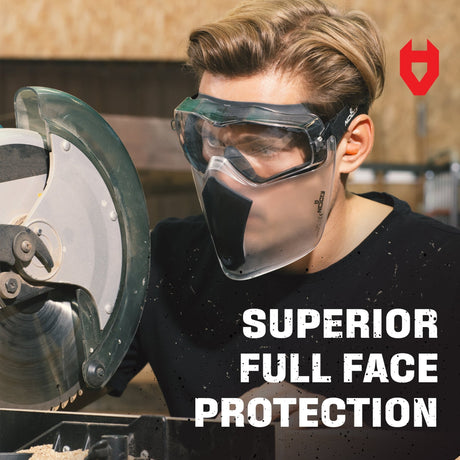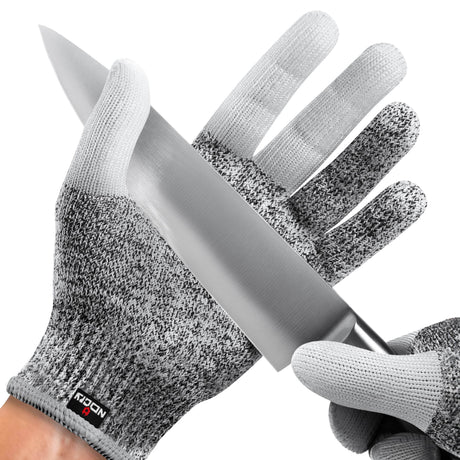Contents
Key Takeaways
- Home accidents led to over 125,000 preventable deaths in 2023, with a death rate of 37.5.
- Top causes of home accidents: Poisoning (77,000 deaths), falls (32,000 deaths), and fire-related incidents (3,100 deaths).
- Falls are the leading cause of injury-related ER visits and fatalities, particularly among older people.
- Home fire fatalities remain steady, with cooking as the leading cause of fires.
- Prevention tips like securing hazardous materials, proper lighting, and safety gear such as safety glasses, helmets, and no-cut gloves can significantly reduce risks.
Introduction
Did you know that over 125,000 people die from home accidents each year? From falls and fires to poisoning and drowning, home accidents are a leading cause of preventable injuries and fatalities. In fact, most accidents happen within 1 mile of home, making home safety more critical than ever. Understanding the most common accidental deaths at home and taking proactive steps can significantly reduce your risk.
This article breaks down the latest home accidents statistics, highlighting the biggest dangers and how to prevent them. Whether it’s installing smoke alarms, securing medications, or wearing safety gear, small changes can make a huge difference.
What Are the Most Common Household Accidents?
In 2023, there were 125,700 preventable injury-related deaths in the US, with 78% resulting from unintentional home accidents. Falls, poisoning, fires, choking, and drowning were the leading causes. These accidents are preventable with proactive safety measures.
Home injuries can also result from exposure to harmful UV rays through windows, digital eye strain from screens, hazards like cleaning agents, sharp objects, electrical shocks from faulty wiring, burns from hot surfaces or liquids, cuts from improper use of knives or tools, slips on wet floors, and injuries from falling furniture or unsecured objects.
To reduce exposure to sun rays, wearing UV protection glasses outdoors and taking measures to block harmful rays indoors can help protect your vision, alongside reducing other home hazards.
Additionally, carbon monoxide poisoning, often from malfunctioning heaters, and accidental gunshot wounds from improperly stored firearms are also common risks. Proactively addressing these dangers can significantly reduce the likelihood of injury in the home.
What Are the Latest Statistics on Home Accidents?
Falls: In 2023, falls were responsible for 72% of injury-related ER visits, with older people at the highest risk. 1 in 3 adults over 65 falls yearly, leading to severe injuries like head trauma or hip fractures.
Poisoning: There were 77,000 poisoning deaths in 2023, a significant jump from the prior year. Over 75% of these were opioid-related. The death rate was notably higher for men (38.3 per 100,000) compared to women (15.1 per 100,000).
Fires: Home fires occurred every 89 seconds in 2020, and the fatality rate remained at 7.2 deaths per 1,000 fires. Cooking-related fires accounted for 49% of all house fires.

Choking: In 2024, 4,963 people died from choking. Seniors comprised most of these incidents, particularly those aged 74 and older.
Drowning: 3,960 drowning deaths occurred in 2023, with children under age 5 being the most affected. Adult drownings often involve alcohol or risky behavior.
Did you know? West Virginia reported the highest death rate from home accidents at 123 per 100,000 residents. In comparison, states like Nebraska and Utah had the lowest rates at 45 per 100,000 residents.
What Percentage of Accidents Happen Close to Home?
Most accidents happen within 1 mile of home because people tend to be less cautious in familiar surroundings. This applies to both car crashes and home-related accidents, as daily routines can lead to complacency.
Common incidents include slips and falls, fires, poisoning, choking, and drowning, often caused by unsecured rugs, cooking mishaps, hazardous chemicals, or unsupervised children.
Since people spend most of their time at home, exposure to risks is higher, making home safety improvements crucial. Installing smoke detectors, securing dangerous items, improving lighting, and using non-slip mats can significantly reduce the chances of accidents in this high-risk zone.
How Can Poisoning Accidents Be Prevented?
Poisoning occurs from medications, household cleaners, chemicals, and carbon monoxide. Prevent it by storing chemicals securely, using childproof locks, labeling substances, installing carbon monoxide detectors, and keeping medicines out of reach.
Poisoning remains a leading cause of home accidents, with 77,000 deaths reported in 2020, primarily from drug overdoses and accidental exposure to hazardous substances.
Poison Prevention Tips:
- Store medicines and chemicals securely: Lock away dangerous substances, such as household cleaners and medications, out of children’s reach.
- Install a carbon monoxide (CO) detector: This can alert you to the presence of this colorless, odorless gas.
- Educate on medication use: Ensure everyone in your home understands the risks of drug misuse.
How To Prevent Falling?
Falls happen due to slippery floors, poor lighting, loose rugs, clutter, and unstable furniture. Prevent them by using non-slip mats, securing rugs, improving lighting, keeping walkways clear, and installing grab bars in bathrooms and stairways.
Falls are the leading cause of injury in the home, especially among older adults. Statistics reveal that 6 in 10 falls happen at home, often involving stairs, bedrooms, and bathrooms.

Fall Prevention Tips:
- Install adequate lighting in areas like hallways, stairways, and bathrooms.
- Declutter your home to eliminate tripping hazards.
- Use non-slip mats in bathrooms and install grab bars for added support.
- Wear safety glasses when working in hazardous areas, especially when cleaning chemicals or sharp objects.
- Consider wearing helmets when using ladders or doing DIY work.
Why Do Home Fires Occur?
Home fires often start due to cooking mishaps, heating equipment, electrical faults, smoking, and candles. Prevent fires by never leaving cooking unattended, maintaining appliances, keeping flammable items away from heat sources, installing smoke alarms, and having a fire extinguisher available.

Home fires are common and dangerous. According to the US Fire Administration, 1,389,000 fires occurred in the US in 2023 alone. In 2021, a home fire occurred every 89 seconds, and cooking-related fires accounted for 49% of all residential fires.
Fire Prevention Tips:
- Install smoke detectors in every room, especially near kitchens and bedrooms.
- Never leave cooking unattended, particularly when using oil or frying.
- Keep flammable items away from heat sources like stoves and space heaters.
- In high-risk areas like the kitchen, use cut resistant gloves when handling sharp objects to prevent accidental injuries.
Why Do People Choke?
Choking is caused by small objects, food, and unsafe eating habits. Prevent it by cutting food into small pieces, avoiding small toys for young children, supervising meals, and learning the Heimlich maneuver for emergencies.
Choking is a leading cause of unintentional injury death. In 2021, 4,963 people died from choking, with elderly adults and young children being most at risk.
Choking Prevention Tips:
- Supervise children during meals and avoid small, hard foods like nuts or popcorn.
- Cut food into small pieces for children to reduce the risk of choking.
- Be cautious with elderly adults, offering softer foods and encouraging slow, deliberate chewing.
How To Prevent Drowning?
Drowning happens in bathtubs, pools, or even small water containers. Prevent it by never leaving children unsupervised near water, using pool fences, covering drains, emptying tubs after use, and learning CPR for emergencies.
Drowning accidents are more common than expected, with 3,960 fatalities in 2023. Children under age 5 are most vulnerable, but adults, especially males, also face significant risks.

Drowning Prevention Tips:
- Supervise children around water at all times.
- Learn CPR to assist in case of emergency.
- Avoid swimming under the influence of alcohol or while fatigued.
Other Statistics
How Is the Home Security Market Affected By Accidents?
The home security industry is valued at $56.1 billion, expected to grow to $93 billion by 2030. Over 39 million US households use alarm systems, with another 13 million considering installation in the next year. This growth is driven by rising concerns about burglary, smart home technology advancements, and increased accessibility of security solutions.
What Are the Key Home Crime Statistics in the US?
- Robbery incidents declined by 2.3% from Q1 2023 to Q1 2024.
- Larceny-theft remains the most common property crime, with 4.3 million incidents in 2022.
- Package theft continues to rise, with 119 million thefts in 2023, affecting 1 in 180 packages.
- Nearly half (48%) of all violent crimes happen at residences.
- Home fire-related injuries occur every 53 minutes, and deaths occur every 3 hours and 14 minutes.
What Are the Latest Trends in the Home Security Market?
- Larceny theft (4.3 million incidents in 2022) remains the most frequent property crime.
- The value of stolen property in 2022 was over $463.5 billion, with only 8% of stolen items recovered.
- Burglars choose targets based on location, number of people, and visible security measures.
- Violent crimes saw a slight decrease in 2022, with 381 violent crimes per 100,000 people.
What Are the Latest Home Fire Statistics?
- US fire departments respond to 1.5 million fires annually, causing three civilian deaths and $18 billion in damage.
- Smoke alarms reduce fire-related deaths by 30%, improving to 71% with hardwired alarms.
- Cooking is the leading cause of home fires, responsible for 44% of incidents.
How Can You Stay Safe in Your Home?
Preventing home accidents starts with simple safety measures. Keeping floors clear of clutter, using non-slip mats, and installing handrails can reduce falls, one of the most common accidental deaths at home. Good lighting in hallways and staircases also helps prevent trips.

To avoid poisoning, store medications and household chemicals in locked cabinets. Installing a carbon monoxide detector can protect against this invisible threat. Always follow medication dosages and keep emergency numbers handy.
Fires are another major risk. Ensure your smoke detectors work, never leave cooking unattended, and keep flammable items away from heat sources. Having a fire escape plan can save lives.
Choking is a hidden danger, especially for kids and seniors. Cut food into small pieces, supervise mealtimes, and avoid giving small objects to children. Learning the Heimlich maneuver can be life-saving.
Drowning prevention starts with supervision. Never leave children alone near water, install self-latching pool gates, and learn CPR for emergencies. Adults should avoid swimming under the influence of alcohol.
For overall safety, wear safety glasses, knee pads, and no-cut gloves when using tools. Keep doors and windows locked, install security cameras, and avoid sharing vacation plans online to deter burglars. Simple precautions make a big difference in keeping your home safe.
Conclusion
Home accidents are prevalent, but many can be prevented with simple safety measures. Understanding the risks and taking steps to mitigate them can significantly reduce the likelihood of serious injuries or fatalities. Stay proactive in maintaining a safe home environment for your family.
FAQ
How can you prevent common accidents at home?
Keep floors clear of clutter, secure rugs with non-slip pads, and install grab bars in bathrooms. Regularly check smoke detectors and store sharp or hazardous items safely out of reach.
What footwear will decrease your risk of a slip and fall?
Wearing shoes with non-slip soles and proper tread can significantly reduce your risk of falling. Avoid walking around in socks, smooth-soled slippers, or bare feet on slippery surfaces.
What percent of accidents happen at home?
Roughly 50% of all accidental injuries happen in the home, according to the National Safety Council. This includes falls, cuts, burns, and other common household incidents.
What happens when a remote worker is injured at home?
If the injury occurs while performing work duties, it may qualify for workers’ compensation coverage, depending on local laws and company policies. Employers are generally responsible for work-related injuries, even if they happen at home.




























1 comment
Holy Cow! Those statistics are insane! I can’t believe how many people get poisoned every year!! I wonder how many of those are really “accidents!” ;)